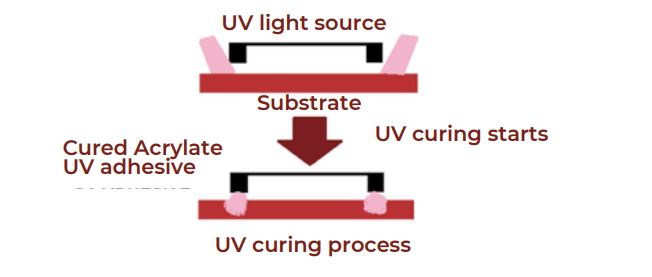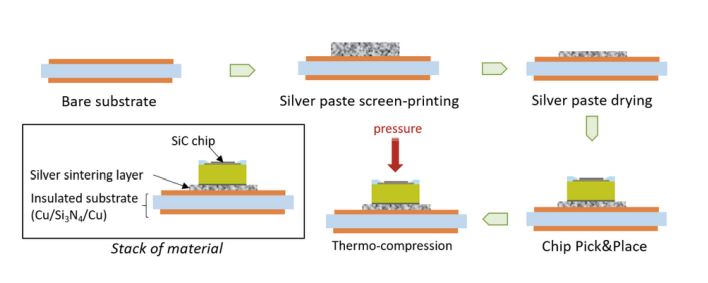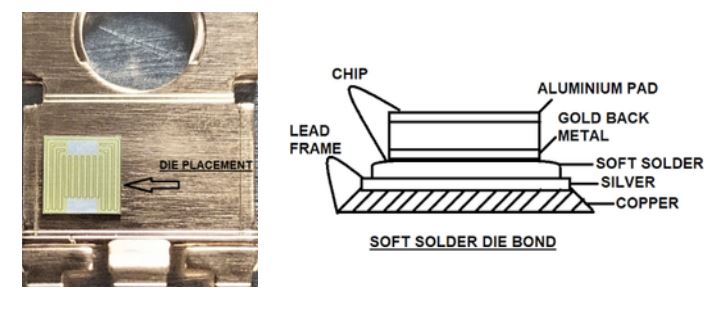Why Die bonding?
- Protecting the die from external factors;
- Redistributing the input and output to a manageable fine pitch;
- Offering the proper thermal pathway to ensure error-resistant and electrical performance.
![]()
Process
The choice of die bonding process depends upon package sealing strategy, operating conditions and environmental and reliability requirements. The die bonding can be generally accomplished by distinct types of attachments. Basically, it will have below steps:

Challenges
The presence of voids might result in low shear strength and low thermal/electrical conductivity and produce die stresses that can lead to die cracking.
Solutions
Non-electrically conductive adhesive: low stress, low voiding, good dielectric properties, high thermal conductivity, less bleed-out, excellent dispensing behavior.
Epoxy Adhesive
An Epoxy Die Attach process is performed by attaching the die to the lead frame with the use of epoxy adhesive on the Epoxy Die Attach Equipment/Die Bonder. A drop of the epoxy adhesive is dispensed on the package using specialized Dispensing Tools and the die is placed on top of it. The package needs to be heated at the required temperature to cure the epoxy adhesive adequately according to the adhesive manufacturer’s specifications. This Die Attach epoxy bond process utilizes polyamide, epoxy, and silver-filled glass as die bond material to mount the die on the die bond pad. The mass of epoxy on the peripheral of the die is known as the epoxy coverage area after the die is bonded.

UV Die Bonding
UV die bonding or UV/Dual cure adhesive attach has the main advantage of being curable in situ, thereby significantly speeding up the entire assembly process and opening up the range of applications to some specific cases. The UV curable adhesives undergo the curing process in the presence of 365nm – 400nm wavelength light.

Electrically conductive adhesive
Adhesive with metal filler such as Ag, heat cure, thixotropic fluid, robust dispense or stencil print performance.
Silver sintering dies bonding or sintering paste
Attach is unique from both solder and epoxies; it neither cures nor does it reflow. Silver-sintered paste instead goes through a process akin to solid diffusion.

Eutectic solder
Eutectic die bonding, sometimes known as eutectic die attach or fluxless eutectic solder attach, is a process that forms high thermally and electrically conductive bonds that are often needed for the densely packed circuits in today’s dies. It is a highly controlled die attach process for high reliability, high accuracy requirement devices.
Eutectic solder is unique in that it is an alloy that has a melting point that is lower than the melting point of the metals that make up the alloy. These melting points are low enough for attachment processes but raise significantly after attachment for thermal stability.

Underfill
Higher I/O counts, package integration, and tighter bump pitches are dictating the use of flip-chip technology to enable advanced package designs. Given these realities, protecting next-generation flip-chip and package-on- package (PoP) devices is more important than ever to safeguard against stress and ensure longterm function and reliability of the component. Underfills in a variety of formats protect delicate, high-density flip-chip connections.
Underfills are usually applied to the package after reflow. Traditional capillary underfills are dispensed to flow in between the solder balls of Ball Grid Arrays (BGAs) and Chip Scale Packages (CSPs) enhancing mechanical and thermal properties.
- Reinforce electronic components
- Minimize stress
- Protect solder joints during thermal cycling
Raise the thermal cycle performance




